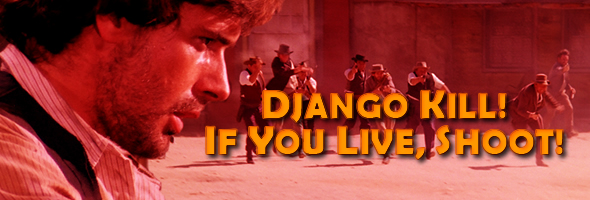
Color, 1967, 116m.
Directed by Giulio Questi
Starring Tomas Milian, Ray Lovelock, Marilu Tolo, Piero Lulli, Milo Quesada, Roberto Camardiel
Blue Underground (Blu-Ray & DVD) (US
R0 HD/NTSC), Argento (UK R2 PAL), Divisa (Spain R2 PAL), Stomp (Australia R4 PAL)/ WS (2.35:1) (16:9)
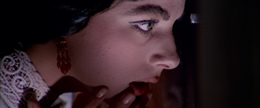 An avant-garde horror film masquerading as a spaghetti western, this outrageous oddity marked the directorial debut of one of Italy's wildest talents, Giulio Questi, who went on to helm the freaked-out giallo Death Laid an Egg and the obscure but equally nutty Arcana. Tasked with directing what seemed like a straightforward western, he turned a tale of revenge into a phantasmagoric gallery of violence, grotesqueries, and kink, foreshadowing the arrival of films like El Topo, Matalo, and The Hunting Party. Not surprisingly, this proved to be more than most audiences (and especially distributors) could take; it remained unseen in the US for decades, and in many countries its most extreme moments of violence were removed entirely. When bootleg copies began popping up on VHS in the '90s, it began to acquire more of a reputation as an essential weird and wild genre mash up, eventually prompting a much-needed official release from Blue Underground.
An avant-garde horror film masquerading as a spaghetti western, this outrageous oddity marked the directorial debut of one of Italy's wildest talents, Giulio Questi, who went on to helm the freaked-out giallo Death Laid an Egg and the obscure but equally nutty Arcana. Tasked with directing what seemed like a straightforward western, he turned a tale of revenge into a phantasmagoric gallery of violence, grotesqueries, and kink, foreshadowing the arrival of films like El Topo, Matalo, and The Hunting Party. Not surprisingly, this proved to be more than most audiences (and especially distributors) could take; it remained unseen in the US for decades, and in many countries its most extreme moments of violence were removed entirely. When bootleg copies began popping up on VHS in the '90s, it began to acquire more of a reputation as an essential weird and wild genre mash up, eventually prompting a much-needed official release from Blue Underground.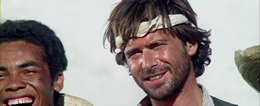
In the opening scene, a nameless half-Mexican gunslinger (Milian, in between The Big Gundown and Face to Face) crawls his way out of a mass grave with the aid of a band of wagon-toting Indian passersby. As jagged flashbacks quickly reveal, he and his Mexican gang were double crossed by the nasty Oaks (My Dear Killer's Lulli) and his crew over a stash of gold, for which Milian and company were forced to dig their own grave and then left for dead after a wave of gunshots. Unfortunately the bad guys also lost most of their horses in the process, forcing them to stop off in a nearby town nicknamed the Unhappy Place where kids are used as footstools out in the open, everyone seems to be physically abused, and even the animals are sick and twisted. Though the town prides itself on being filled with good and upstanding citizens, it wastes no time shooting and stringing up most of the gang, while Milian arrives just in time to plug some gold bullets into Oaks' abdomen (which leads to the film's most notorious and gruesome scene). You'd think that revenge plot would be enough for an entire movie, but nope, that's just the first half hour. 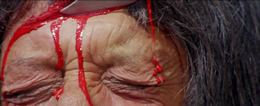 Now our hero also has to contend with more strangeness: a chubby degenerate named Zorro (Camardiel); a squad of black-leather cowboys who want to use the town pretty boy, Evan (a disconcertingly young Lovelock, way before Let Sleeping Corpses Lie), as their personal human piñata; and torture by fruit bats(?) while trussed up in a jail cell.
Now our hero also has to contend with more strangeness: a chubby degenerate named Zorro (Camardiel); a squad of black-leather cowboys who want to use the town pretty boy, Evan (a disconcertingly young Lovelock, way before Let Sleeping Corpses Lie), as their personal human piñata; and torture by fruit bats(?) while trussed up in a jail cell.
Sound bizarre? Yep, it is, and definitely not for all tastes, especially traditional western fans. However, if you're looking for a zonked-out cult item with unpredictable twists and turns around every corner, you've come to the right place. Obviously there's no actual Django to be found a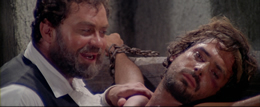 nywhere; the original Italian name, Se sei vivo spara, only accounts for half of the English title. Milian is excellent as usual, even if he's much more passive than usual as he's mainly beaten up, stripped, and confined for much of the running time, and Questi piles on the violence in spades including a shockingly nasty scalping whose thick red paint only partially mitigates its graphic punchline.
nywhere; the original Italian name, Se sei vivo spara, only accounts for half of the English title. Milian is excellent as usual, even if he's much more passive than usual as he's mainly beaten up, stripped, and confined for much of the running time, and Questi piles on the violence in spades including a shockingly nasty scalping whose thick red paint only partially mitigates its graphic punchline.
Blue Underground's 2003 DVD was a pretty big deal in certain circles, as it marked the first time this film could be seen in its much longer 116-minute form (most prints were missing up to 20 or 30 minutes). Originally included in their excellent spaghetti western box set, it was then issued as a single disc; it's still a nice release, with an attractive scope transfer and both English and Italian language options (with Italian only for a handful of the more extreme scenes never dubbed into English). Neither one matches the lip movements, so you might as well go with the Italian one; it has numerous extra lines of dialogue dropped in the other track (perhaps due to lazy dubbers?) and sounds much more easy on the ears. Interestingly, the bar song performed early in the film (and which goes on, and on, and on) is wildly out of synch on both tracks, so God only knows what was actually being sung on the set. It's almost as ridiculous as the people "dancing" early on in The Poseidon Adventure to its theme song. The UK disc appears to be from the same source and features an impassioned intro by director Alex Cox and interviews with Lovelock and Questi.
The 2012 Blu-Ray revisit by Blue Underground will come as a solid albeit imperfect upgrade for fans, containing a sharp leap in quality over the already nice original release. Colors look vivid and... well, "natural" isn't really the word when you're talking about candy-colored blood, but they seem to be accurate. The increase in resolution also makes it more obvious that a handful of shots (presumably from the same camera) look much softer and borderline out of focus; on the more conspiratorial side, that may also be due to some aggressive noise reduction if the shots were originally loaded with excessive grain, but it's tricky to judge when you only have a standard def counterpart for comparison. As usual, it appears some noise reduction has been applied elsewhere in spots ranging from almost indistinguishable to pretty freaking obvious, so those sensitive to it may have to determine their mileage here. The DTS-HD mono audio also sounds terrific in both options, complete with English subtitles (both for the English dub and translating the Italian track) along with additional subs in French and Spanish. Extras are the same as the DVD, namely an odd theatrical trailer (which contains no actual footage from the film), a gallery of posters and stills, and best of all, a video featurette, "Django, Tell!," with Questi, Milian, and (briefly) Lovelock sharing their memories of working on the film. It looks like this was originally shot in SD, but the clips from the film itself appear to have been replaced here with HD ones from the new transfer, a nice touch. Questi has the best moments here as he talks about how and why he made the leap to narrative filmmaking after war service and a career in documentaries and shorts, while the bearded Milian is his usual articulate and charming self.
Reviewed on June 4, 2012.
 An avant-garde horror film masquerading as a spaghetti western, this outrageous oddity marked the directorial debut of one of Italy's wildest talents, Giulio Questi, who went on to helm the freaked-out giallo Death Laid an Egg and the obscure but equally nutty Arcana. Tasked with directing what seemed like a straightforward western, he turned a tale of revenge into a phantasmagoric gallery of violence, grotesqueries, and kink, foreshadowing the arrival of films like El Topo, Matalo, and The Hunting Party. Not surprisingly, this proved to be more than most audiences (and especially distributors) could take; it remained unseen in the US for decades, and in many countries its most extreme moments of violence were removed entirely. When bootleg copies began popping up on VHS in the '90s, it began to acquire more of a reputation as an essential weird and wild genre mash up, eventually prompting a much-needed official release from Blue Underground.
An avant-garde horror film masquerading as a spaghetti western, this outrageous oddity marked the directorial debut of one of Italy's wildest talents, Giulio Questi, who went on to helm the freaked-out giallo Death Laid an Egg and the obscure but equally nutty Arcana. Tasked with directing what seemed like a straightforward western, he turned a tale of revenge into a phantasmagoric gallery of violence, grotesqueries, and kink, foreshadowing the arrival of films like El Topo, Matalo, and The Hunting Party. Not surprisingly, this proved to be more than most audiences (and especially distributors) could take; it remained unseen in the US for decades, and in many countries its most extreme moments of violence were removed entirely. When bootleg copies began popping up on VHS in the '90s, it began to acquire more of a reputation as an essential weird and wild genre mash up, eventually prompting a much-needed official release from Blue Underground.
 Now our hero also has to contend with more strangeness: a chubby degenerate named Zorro (Camardiel); a squad of black-leather cowboys who want to use the town pretty boy, Evan (a disconcertingly young Lovelock, way before Let Sleeping Corpses Lie), as their personal human piñata; and torture by fruit bats(?) while trussed up in a jail cell.
Now our hero also has to contend with more strangeness: a chubby degenerate named Zorro (Camardiel); a squad of black-leather cowboys who want to use the town pretty boy, Evan (a disconcertingly young Lovelock, way before Let Sleeping Corpses Lie), as their personal human piñata; and torture by fruit bats(?) while trussed up in a jail cell.  nywhere; the original Italian name, Se sei vivo spara, only accounts for half of the English title. Milian is excellent as usual, even if he's much more passive than usual as he's mainly beaten up, stripped, and confined for much of the running time, and Questi piles on the violence in spades including a shockingly nasty scalping whose thick red paint only partially mitigates its graphic punchline.
nywhere; the original Italian name, Se sei vivo spara, only accounts for half of the English title. Milian is excellent as usual, even if he's much more passive than usual as he's mainly beaten up, stripped, and confined for much of the running time, and Questi piles on the violence in spades including a shockingly nasty scalping whose thick red paint only partially mitigates its graphic punchline. Reviewed on June 4, 2012.
![]()